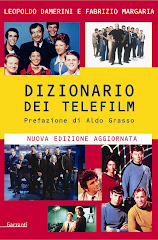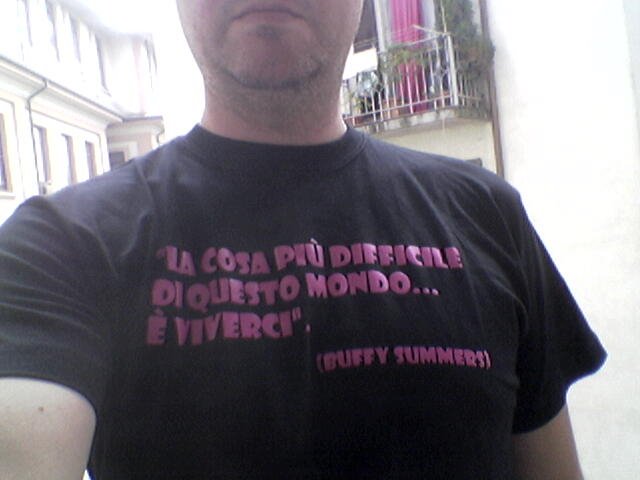NEWS - Ecco perchè "Breaking Bad" e "House of Cards" hanno ucciso gli Oscar!
The
best movies get made because filmmakers, financiers, champions, and a
great many gifted creative people stubbornly ignore the obstacles. The
question going forward is how adaptive all these people are. How long
will they struggle before they give up on the film business and take
their talents elsewhere? And how flexible is the industry itself?
As AMC’s TV drama
Breaking Bad took
over the water-cooler conversation in 2013, and television critics
dominated Twitter in a way that no movie debaters did, it served to
reinforce the fact that film’s glory days are over. In today’s
omnivorous world, it’s no longer about seeing the new movie opening on
Friday or waiting eagerly for the next
New Yorker review.
Cinephiles go to film festivals for their fix, or to SnagFilms,
Criterion, Indieflix, Fandor, Mubi, or Turner Classic Movies. Why schlep
out to the new
Dumb and Dumber sequel when the glories of
Hollywood’s Golden Age are easily Netflixed? (As of this writing,
Netflix boasts “38 million members in 40 countries enjoying more than
one billion hours of TV shows and movies per month, including original
series” even partnering with Marvel on four new live-action MTV series)
Even the
New York Times film critic A. O. Scott admitted that he was according many of his weekly viewing hours to television—just like everyone else.
There
was a time during the golden age of the studio system when Hollywood
churned out hundreds of quality films for grownups. In many ways 2012
boasted the best crop of films since the banner year of 1939 that
yielded
Gone with the Wind, Mr. Smith Goes to Washington, Wuthering Heights, Stagecoach, The Wizard of Oz, Ninotchka, and
Dark Victory.
Six
of the nine 2012 Best Picture Oscar nominees passed the $100 million
mark—the biggest numbers, even with ticket-price adjustments, in recent
box-office history. All six were released in the later part of the year.
So why don’t the studios finance even more quality “prestige”
films—by proven directors, at high budget levels—and aggressively back
them, aiming for mass audiences all year long?
Admittedly,
this is hard to do. It demands confidence and risk-taking. In late
2012, the studios released a group of films that were made by directors
who had won Best Picture and/or Best Director (Steven Spielberg’s
Lincoln, Sam Mendes’s
Skyfall, Ang Lee’s
Life of Pi, Robert Zemeckis’s
Flight, Kathryn Bigelow’s
Zero Dark Thirty, Peter Jackson’s
The Hobbit, Tom Hooper’s
Les Misérables),
and all but one of those films were released initially in over 2,000
theaters, rather than platformed like the majority of top Oscar
contenders in most other years—which is the usual sign of high awards
expectations. And they all not only earned consensus rave reviews
but made a healthy profit. (Specialty Oscar nominees
Amour and
Beasts of the Southern Wild took the usual slow-release route.)
But
despite 2012’s bountiful harvest of strong, substantive films and
action and animated blockbusters that scored record global box office,
from
Brave to
The Hunger Games, there’s precious
little optimism about the future of movies. The Best Picture Oscar
nominees (whether in 2012 or 2013) are always exceptions that prove the
rule, from outsiders jumping over the wall at Sundance (
Beasts of the Southern Wild) to insiders willfully refusing to play by the rules (
12 Years a Slave).
Sure, the studios will permit a few top-of-the-line filmmakers to chase
adults in the fourth quarter, but no wholesale changes are in store.
No wonder Spielberg was pissed off. He saw a crowd pleaser in
Lincoln. And
he was right. It was the top-grossing Oscar contender ($182 million),
the eleventh most successful domestic performer of 2012. Why was it so
difficult to get traditional studio financing? Like many independents
these days, Reliance-backed DreamWorks cobbled together presales on
territories overseas (via Twentieth Century Fox, which also took
home-video rights) and brought in an outside investor (Participant
Media) to fund the movie, which was released by DreamWorks distributor
Disney.
The old days of studio largesse are over—even for
Spielberg, arguably the most powerful and versatile filmmaker in
Hollywood. And if he has to hustle, what about the hordes of less
prepossessing talent who find themselves frozen out by the studios?
They’re heading where the money is: foreign financing, television,
cable,
HBO, or
Netflix.
While the studios could build on these
year-end successes and try to make more of them, they won’t. While they
could try to diversify and make movies for underserved constituencies
like Hispanics, African Americans, adults, and women, they won’t.
They’d rather stick to what they know: cookie-cutter movies for
families and young men, and throwing millions of dollars at building a
bigger mousetrap. Truth is, the more expensive a movie, the tougher
it is for it to have any noticeable personality: all the edges get
shaved off. By default the picture has to appeal to the widest number
of people—all over the globe. That’s how genre formula, nonstop
action, and eye-popping pixel effects keep trumping witty dialogue and
old-fashioned storytelling.
To the winners go the spoils. But 2013
revealed the hazards of the tentpole, all-or-nothing approach. Just as
Spielberg predicted in his June 12, 2013, panel at USC, six costly
would-be summer blockbusters tanked domestically, although a few were
barely bailed out by their international grosses. 2013 proved the
cyclical theory held by the late A. D. Murphy, a
Variety box-office analyst
and professor at USC’s Peter Stark program. He declared that it’s
perilous to follow the trends of what works at the box office, because
when the studios throw imitations of recent hits at moviegoers,
moviegoers inevitably get bored. Tom Rothman, an eighteen-year Fox
veteran and Fox chairman and CEO until January 2013, who during
his tenure backed such risky films as Peter Weir’s
Master and Commander and Ang Lee’s
Life of Pi,
concurs: “Movies struggled this summer because they were, essentially,
all the same and the audience was bored. No longer can an audience be
pounded into attendance by dint of spending. Now, exactly because of how
much great work there is on television, films have to raise the bar, to
be more original, more complex, more imaginative, more daring. That is
hard because of the huge cost/risk involved, and cost often has an
inverse relationship with creativity. But I am fervently optimistic.
We can make the films for less, sell them for less, and push
creative boundaries more. And when we do, the audience will set the
DVR, go out of the house, and come to the theaters. As long as we
don’t underestimate them, they will reward us.”
In Hollywood you
have to keep moving and stay ahead of the trends. And being able to
adapt to digital is key, as is the recognition that consumers’ viewing
habits have irrevocably changed.
From the point of view of the
seven major studios, the migration of film talent to television isn’t an
issue, because their corporations are not losing income; they own
pieces of that business too. If HBO makes money, that’s good for Warner
Bros. Viacom and Paramount want MTV, VH1, and CBS to succeed. Comcast
owns Universal and NBC; Disney owns ABC and ESPN; Sony produces
Breaking Bad, Jeopardy, and
Wheel of Fortune; and Lionsgate roots for its own shows on AMC Networks.
Tellingly,
three studios (Disney/ABC, Twenty First Century Fox, and NBC Universal)
decided to hang on to their online streaming service, Hulu, instead of
selling it. Finally, they recognized its value—and didn’t want anyone
else to get it. Hulu has conducted valuable experiments in what
audiences want, even if it’s mostly TV shows. But challenging the
studios’ dominance in entertainment are digital powerhouses Google,
Apple, Amazon, and Netflix. They are encroaching more and more on the
studios’ territory—as Apple did in the music business. Mobiles are the
new window into viewing content, and everyone knows it.
Netflix
and Amazon are all about giving their customers what they want by
constantly tweaking complex algorithms to determine how to anticipate
consumer desires. That’s how Netflix knew their subscribers would love a
remake of
House of Cards, directed by
David Fincher and
starring Kevin Spacey, and banked $100 million launching their own
content division. They probably won’t spend that much again, but they
were right. Their high-stakes gamble paid off and made them a
potentially strong competitor to
HBO, Showtime, FX, and
AMC.
While
the studios are trying to hang on to their market-share dominance, they
are keenly aware that smaller, more nimble companies with less to lose
have more freedom to experiment. They saw the music industry’s rapid
decline, reinvention, and ascension. The indies can take advantage of
new funding sources like Kickstarter and IndieGoGo, produce microbudget
films that can make back their money by reaching out to burgeoning
online fanbases, and figure out the video-on-demand paradigm as the old
windows model eventually falls away. The new indie entrepreneurs are
getting their scripts rated on Spec Scout or The Black List. They
are connecting with potential investors and sales agents through
Slated. They’re going to Seed & Spark for marketing expertise,
hiring the best marketing and distribution experts, and using
on-demand theater-booking service Tugg to predetermine audience interest
in seeing their film in specific markets before making a booking
as they control their medium and message.
Digital is winning, even
inside the studios. Kevin Tsujihara grabbed the reins at the Warner
Bros. studio, knocking out his rivals from TV and motion pictures.
Comcast’s Steve Burke let go the movie-bred chairman of Universal, Adam
Fogelson—even after what looked like a successful year in 2012—in favor
of cable guy Jeff Shell. After a rocky box office in 2013, Sony replaced
their marketing chief with their digital marketing pro. And
innovative digital-marketing guru Amy Powell—who pioneered
Paramount’s on-demand booking of movies—continues to rise in the
executive ranks at that studio.
The motion picture CEOs aren’t
stupid. While they may be hanging on tight to the old ways so that they
can grab as much short-term cash as possible via top-down models that
manipulate consumers by telling them what to buy, they know the ground
under their feet is unstable. In order to survive they will have to
learn to listen to their customers, find out what they want and how to
best serve them. The old strategies in the movie business are
disintegrating, as the ownership model gives way to one that is all
about access. Adapt or die.
From the book “The $11 Billion Year: From Sundance to the Oscars, an Inside Look at the Changing Hollywood System” by Anne Thompson. Copyright 2014 by Anne Thompson. Reprinted by permission of It Books, an imprint of HarperCollins Publishers.


















.jpg)















1 commento:
molto interessante
Posta un commento